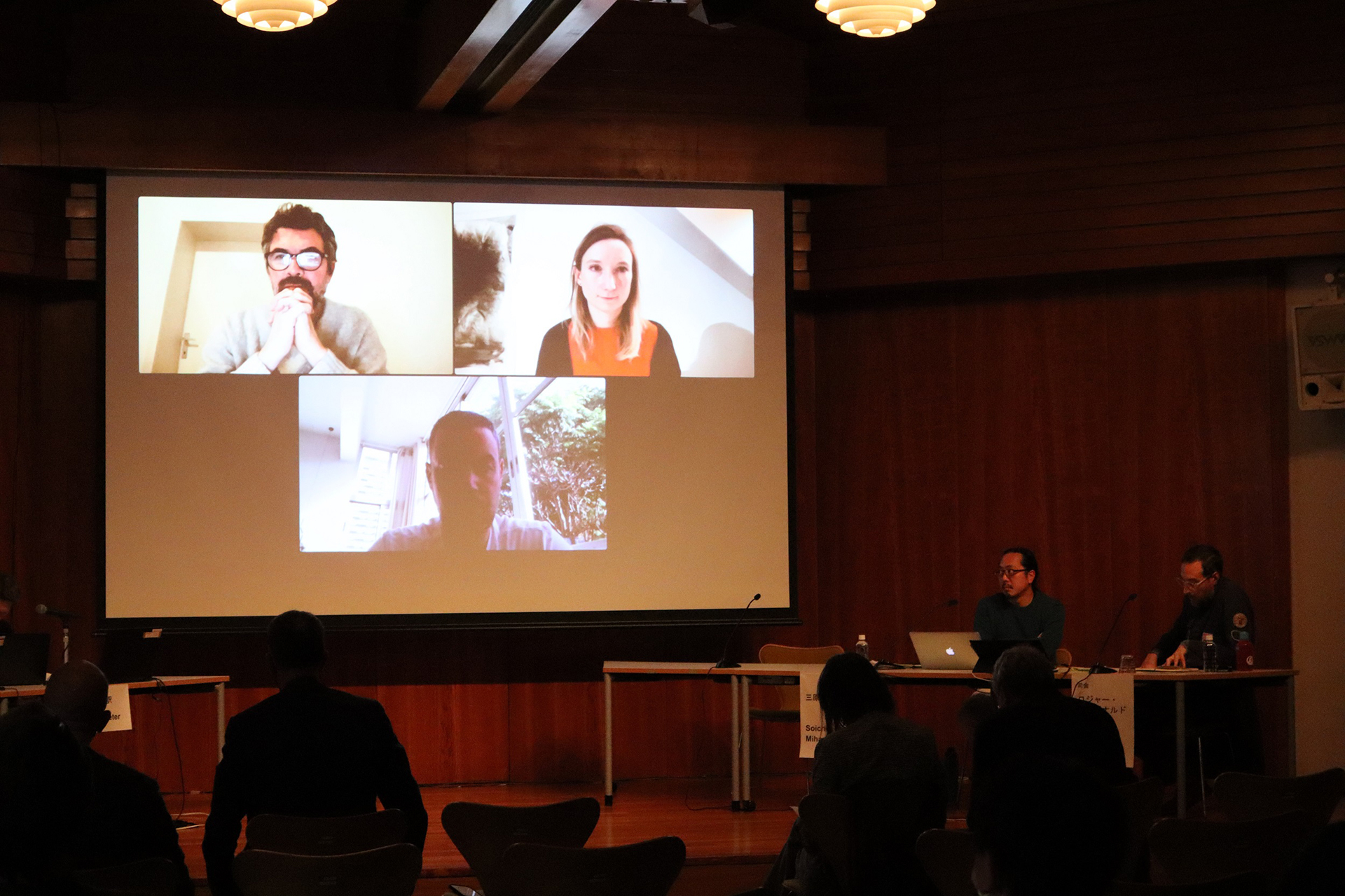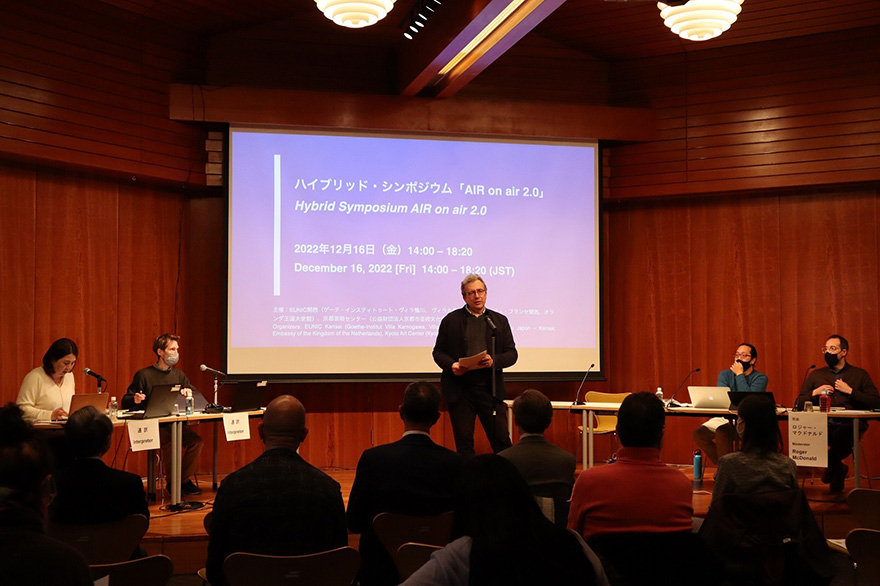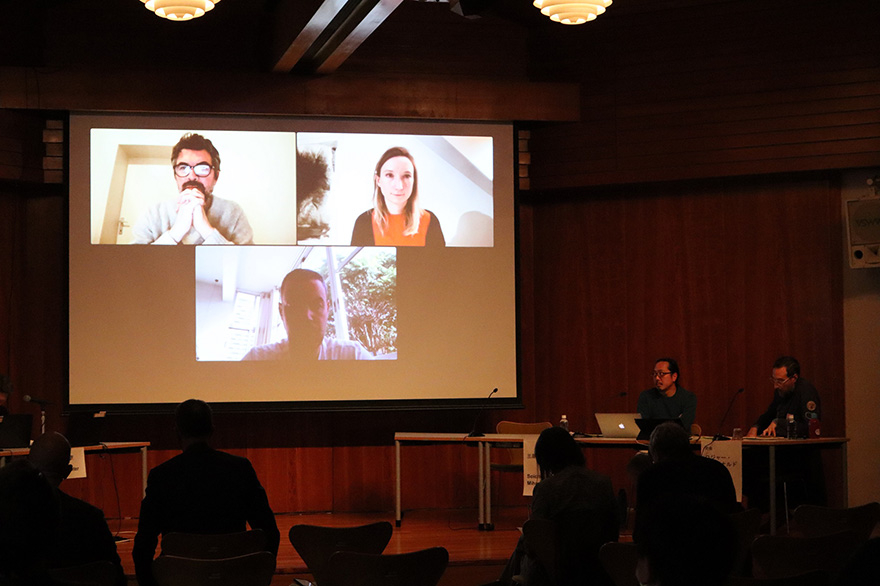AiR News
AIR on air 2.0: Part 1
By Ishii Jun'ichiro

To commemorate the establishment of EUNIC Kansai in 2022, EUNIC Kansai and Kyoto Art Centre organized a hybrid symposium “AIR on air 2.0”. This symposium took over the discussions from the online symposium “AIR on air” held in December 2020 under Corona, confirm the current position of artist-in-residence (AIR) under the rapidly shifting social conditions and discuss what kind of changes are required.
Ishii Jun’ichiro, who is the ICA Kyoto’s residencies coordinator, has reported about the symposium on “AIR_J Online Database of Artist in Residence Programs in Japan“.
“The hasty extinguishing of fires during the pandemic is partially coming an end, but this crisis has given way to realization of other things: wars, tensions and of course global warming. So, we must deal with the question of how we can and how we want to live on this planet.”
The above statement was made by Enzio Wetzel, director of the Goethe-Institut Villa Kamogawa, at the opening of the hybrid symposium AIR on air 2.0, organized by the Goethe-Institut Villa Kamogawa, Villa Kujoyama, Institut français du Japon-Kansai, Embassy of the Kingdom of the Netherlands in Japan, and Kyoto Art Center.
How can artist-in-residence (AIR) programs, which provide spaces for artistic creation, support the activities of artists? Is it their function to preserve artistic freedom? Or is it their mission to extend freedom to the new demands we face on a global scale?
Two years ago, in December 2020, at the first AIR on air symposium held online as our freedom of movement was greatly restricted due to the Covid-19 pandemic, participants discussed the outlook for AIR from the perspectives of freedom of mobility, decarbonization (green mobility), and digitalization. At AIR on air 2.0, the focus was narrowed down in particular to the two topics of “Art Production and the Climate Crisis” and “Solidarity and Care,” with experts in various fields invited to exchange opinions in a hybrid format.
Today, in what is beginning to be called the “post-pandemic” era, what functions are required of AIR programs? In her opening address, Eva Nguyen Binh, the president of the Institut français Paris, stated:
“Some of the questions that would be interesting to discuss are what type of residencies are suitable for this post-pandemic period. We organized a special residency, for example, for 100 Lebanese artists right after the explosion of the port of Beirut, so 100 artists came to France after this explosion. We also welcome Ukrainian artists. So, how can we welcome them best in this time of crisis, and what happens after the residency while the crisis is still going on their country?”

Photo: AIR on air 2.0
Session 1.Art Production and the Climate crisis – Perspectives from Europe and Japan
In the first part of the symposium, four presenters spoke on the subject of “Art Production and the Climate Crisis.”
Martin Germann, an adjunct curator at the Mori Art Museum, raised the examples of Lothar Baumgarten (1944–2018), whose work was presented at the Aichi Triennale 2022, and Nancy Holt (1938–2014), whose collaborative work with her partner Robert Smithson (1938–1973) was screened as part of the Mori Art Museum’s MAM Screen 017.
In the late 1960s and early 1970s, from on an ecological viewpoint in particular, Baumgarten eschewed Western discourses and the thought systems that drive modern society, and instead found inspiration in the sustainable lifestyle of the Yanomami people who live in the Amazon rainforest.
In the 1980s, Holt, who had pursued various artistic activities, began to focus on the infrastructure that surrounds us. Infrastructure is always present as part of our environment, yet despite this, is normally invisible. Rather than “creating” works by adding something to physical material, Holt adopted an approach of “making visible” things that already existed but were no longer visible.
Germann points out that the problems we face today did not suddenly begin to occur recently, that they existed in the 1960s, 70s and 80s and that by looking at the approaches adopted by artists of that period we can perhaps get a clearer picture of what we should be thinking about today.
◉
The second presenter, Giulia Bellinetti from the Jan van Eyck Academie in the Netherlands, introduced the Future Materials Bank, which the Jan van Eyck Academie has been developing in collaboration with the MA Material Futures at Central Saint Martins, University of the Arts London (UAL); and the Green Art Lab Alliance (GALA) since 2020.
The Future Materials Bank is an online “materials archive” developed to support and promote sustainable art practices. As of February 2022, the bank’s collection contains information and samples relating to more than 300 non-toxic and sustainable materials submitted by artists, designers and other practitioners in various regions around the worlds. According to Bellinetti:
“We call them “future materials” in terms of being future proof; they are not necessarily new materials, so we also share questions concerning the idea of futures, and the tendency of looking always for the novelty and innovation.”
The Future Materials Bank aims to revive art practices that maintain a better balance between humans and the environment by reusing and rediscovering traditional craftworks and their techniques, and to inspire those involved in art and design to follow their example.
◉
The third presenter, Mihara Soichiro, is an artist who uses technology to create works on the theme of the cycles of nature. He introduced three of his own works related to environmental destruction and climate change.
Created in response to the 2011 Tohoku earthquake and tsunami, the sound installation bell (2013) uses a radiation sensor to measure the level of radiation in the exhibition space and triggers a wind chime depending on the result.
At first sight, the triggering of a wind chime inside a dome with no air circulation is a peculiar phenomenon. Traditionally in eastern Japan, bells or chimes were placed on the boundary between the world inhabited by humans and the world beyond and served to alert people to evil entering from outside. With this work, Mihara sought to visualize radiation, something invisible to humans, not just as a measuring instrument and numerical data but also as a cultural experience.
In Res Nullius (2020), Mihara deals with the subject of water, something we come into contact with unconsciously on a daily basis. Floods and droughts are reported on increasingly frequently due to global climate change, but where exactly is water to begin with?
When air containing water vapor is cooled and condenses, moisture appears as “condensation” on the surfaces of objects. Making use of this phenomenon, Mihara generates moisture from the air inside an exhibition space equipped with cooling devices and produces what appear to be “rivers” and “rain,” depicting the water cycle to which we normally pay little attention.
Lastly, Mihara, whose practice combines natural phenomena and media technology, introduced the compost project he has been working on since the Tohoku earthquake and tsunami. Titled Making Soil (2021), this project, described by Mihara as “a dialogue with microorganisms that use air (oxygen),” is still ongoing, with images of the bucket being rotated and air being mixed into the compost streamed online in real-time.
◉
The final presenter in Session 1 was Felix Große-Lohmann, who runs an art space called Husslehof in Frankfurt, Germany. After seeing artists using worn-out materials in their practices, Große-Lohmann decided to establish Material für Alle as a used materials warehouse.
A lot of materials are used in exhibitions, some of which are expensive and precious. It is difficult to believe that these materials are thrown away after being used just once. By saving materials that have been used once and managing them in such a way that artists and art producers can reuse them in new exhibitions, Große-Lohmann’s initiative encourages the reuse of resources.
Two things are required for the handling of used materials: a large space to store the materials, and a method for managing them. In collaboration with the Technical University of Darmstadt, Material für Alle developed a digital application, both making it easier for people to access the materials by digitizing them and enabling them to be used as part of digital design processes.
“What we try to do is save these materials and store them in our local storage to make them accessible to artists and art producers to re-use for new exhibitions.
So what we really try to do is use the material overshoot of institutional art productions like theaters, museums, stages, fairs; and make this material accessible for artistic practices.”
At documenta 15 held in Kassel in 2022, a room was installed using part of an old stage set to raise awareness of the issue of recycling in art. The oversized dog’s head recreated inside the room incorporated 200 square meters of fur and an internal structure made of steel.
Today, when resource shortages have become more and more apparent due to Russia’s military action and the aftereffects of the Covid-19 pandemic, these acts of reuse are becoming increasingly important. It is against this backdrop that Material für Alle (literally “materials for everyone”) is seeking to deepen the discussion concerning the organized reuse of materials.
◉
At the end of the first round of presentations, Roger McDonald, program director at the NPO Arts Initiative Tokyo and the moderator for Session 1, addressed the issue of climate change (or perhaps now better referred to as “climate crisis”), suggesting that although we all live on the same planet, our awareness at the level of daily life appears to differ dramatically depending on the country or region we live in, on the way we obtain information from the media, and on the kind of social or political system we live under.
In the face of these and other problems that confront us today on a global scale, what kind of thought processes and attitudes can we adopt? Through symposiums like this one and in particular through global AIR networks that have strong horizontal connections, we can learn about initiatives occurring in various locations around the world. By listening to voices from faraway places and thinking about things together, perhaps each of us can return to our own regions and engage in our own specialized activities with our “sense of the times” maintained (or even heightened).
to “AIR on air 2.0: Part 2“
Photo: AIR on air 2.0
Hybrid Symposium “AIR on air 2.0”
Date: 16 December 2022
Goethe-Institut Villa Kamogawa and online (Zoom)
Session 1: Art Production and the Climate crisis – Perspectives from Europe and Japan
Soichiro Mihara, Artist, Japan
Giulia Bellinetti, Jan van Eyck Academie, the Netherlands
Martin Germann, Adjunct Curator, Mori Art Museum, Germany/Japan
Felix Große-Lohmann, Director, Material für Alle & Husslehof, Germany
Moderator: Roger McDonald, Program Director, Arts Initiative Tokyo [AIT], Japan
Session 2: Solidarity and Care
Heidi Vogels, DutchCulture I TransArtists, Artist, The Netherlands
Juliet Knapp, Co-director, International Performing Arts Festival KYOTO EXPERIMENT, Japan
Mykhailo Glubokyi, Development director, IZOLYATSIA, Ukraine
Vincent Gonzalvez, Head of the Residencies, Cité internationale des arts, France
Moderator: Mayumi Yamamoto, Kyoto Art Center artistic adviser, Kyoto city cultural policy coordinator, Japan
Organizers: EUNIC Kansai (Goethe-Institut Villa Kamogawa, Villa Kujoyama, Institut français du Japon – Kansai, Embassy of the Kingdom of the Netherlands), Kyoto Art Centre (Kyoto Arts and Culture Foundation)
Cooperation: AIR_J, The German Consulate General Osaka-Kobe, The Netherlands Consulate-General in Osaka
Thanks to Mami Odai (Sapporo Tenjinyama Art Studio), Shintaro Tokairin (Arts Initiative Tokyo [AIR])
EUNIC Kansai
EUNIC – European Union National Institutes for Culture – is the European network of organizations engaging in cultural relations. The EUNIC Kansai cluster was officially established in June 2022 on initiative of Goethe-Institut Villa Kamogawa, Villa Kujoyama, Institut français du Japon – Kansai, and the Embassy of the Kingdom of the Netherlands in Japan. EUNIC Kansai aims to be a cultural bridge between the European Union and the Kansai area of Japan. It contributes to the connectivity of the cultural sectors in Europe and Kansai and the mobility of European and Japanese artists.